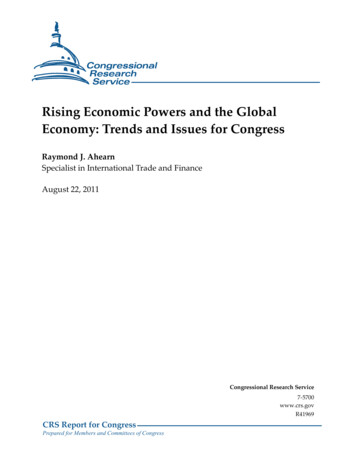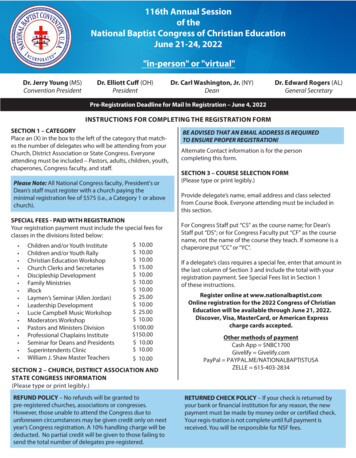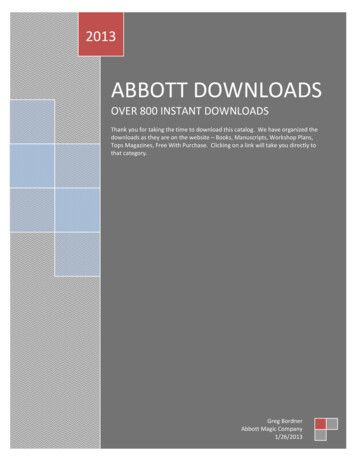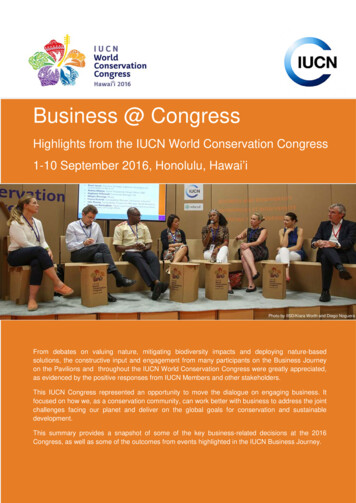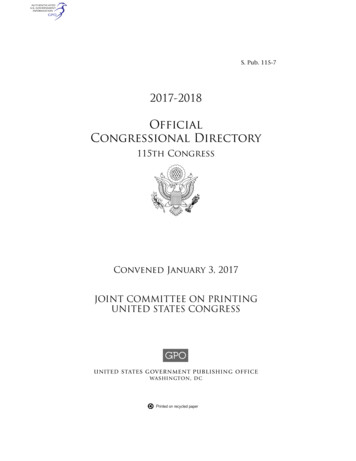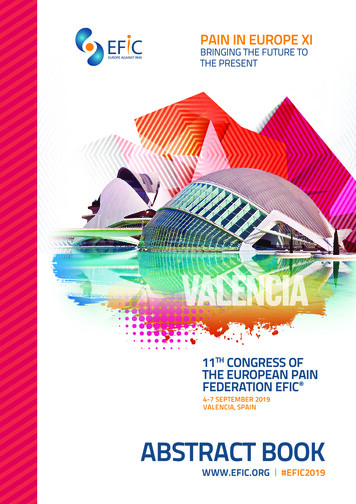
Transcription
PAIN IN EUROPE XIBRINGING THE FUTURE TOTHE PRESENT11TH CONGRESS OFTHE EUROPEAN PAINFEDERATION EFIC 4-7 SEPTEMBER 2019VALENCIA, SPAINABSTRACT BOOKWWW.EFIC.ORG#EFIC2019
PAIN IN EUROPE XIABSTRACT BOOK2
PAIN IN EUROPE XIABSTRACT BOOKTable of contentsORAL COMMUNICATIONS SESSION ABSTRACTS4POSTER BOARD SESSION ABSTRACTS30EPOSTER ABSTRACTS418ABSTRACT AUTHOR INDEX6933
PAIN IN EUROPE XIABSTRACT BOOKORAL COMMUNICATIONS SESSION ABSTRACTS4
PAIN IN EUROPE XIABSTRACT BOOKORAL COMMUNICATIONS 1 - BASICS IN PAINO01CAN OXYTOCIN INFLUENCE PLACEBO AND NOCEBO EFFECTS IN PAIN?A. Skvortsova1, D. Veldhuijzen1, H. van Middendorp1, O. Van den Bergh2, L. Colloca3, A. Evers1Leiden University, Health, Medical and Neuropsychology, Leiden, Netherlands, 2KU Leuven, Health Psychology,Leuven, Belgium, 3University of Maryland School of Nursing, School of Medicine, School of Medicine, Baltimore,United States1Placebo effects relieve pain but it is yet unclear how they can be enhanced to maximize positive treatment outcomes.Oxytocin may potentially be a mediator of the placebo effect due to its trust enhancing and stress relieving actions.In two studies, we investigated the influence of oxytocin on placebo analgesia and hyperalgesia. In the first study,108 female participants were allocated to one of four groups: oxytocin with positive verbal suggestions, placebo withpositive verbal suggestions, oxytocin without suggestions, and placebo without suggestions. The administration of 24IU oxytocin or a placebo spray was preceded by positive verbal suggestions regarding the pain-relieving propertiesof the spray or no suggestions. Pain was assessed with a cold pressor test. In the second study, 80 male participantswere allocated to an oxytocin or a control group. After the administration of 40 IU of oxytocin, they received verbalsuggestions regarding a sham electrode that was said to increase or decrease their pain sensitivity depending onthe mode indicated by a visual cue. To induce and test placebo analgesia and hyperalgesia, a conditioning task wasused in which visual cues indicated low, medium or high heat pain. Positive verbal suggestions and a combination ofsuggestions and conditioning induced significant placebo analgesia and hyperalgesia. No evidence was found thatoxytocin influences placebo effect, using female and male samples and also different dosages of oxytocin. Futureresearch should focus on other possible mediators of the placebo effect such as, for example, vasopressin or otherpharmacological agents.O02DEVELOPING A BIOPSYCHOSOCIAL PAIN AND OPIOID USE CURRICULUM FOR MEDICAL STUDENTS ATMAYO CLINICJ. Sperry1, A. Seegmiller-Renner2Mayo Clinic, Rochester, United States, 2Mayo Clinic, Office of Applied Scholarship and Education Sciences,Rochester, United States1Medical schools must equip future physicians to provide appropriate biopsychosocial care for patients with painand problematic opioid use. A recent systematic review of 383 medical schools1 found minimal instructional timeand limited breadth of content dedicated to pain. This session will review the Mayo Clinic’s development of acomprehensive pain and addiction curriculum.Methods: A Pain and Opioid Curriculum Subcommittee was formed in 2018. A gap analysis using curriculummapping of objectives identified gaps in existing curriculum as compared to International Association for the Studyof Pain2 Core Competences for Pain Management. A survey of graduating medical students indicated perceivedknowledge and confidence gaps in biopsychosocial evaluation and treatment of acute and chronic pain, pediatricpain, and opioid use disorder as well as ratings of satisfaction with current curriculum.Results: Curriculum is being integrated both vertically and horizontally to provide a longitudinal learning experiencein biopsychosocial aspects of pain and opioid use from first to fourth years. We mapped current curriculum andforecast increasing curriculum by 25% yearly for next 4-5 years. To date, we have increased content by 15%,expanding didactic and experiential learning opportunities for medical students in all 4 years. A survey of graduatingmedical students will be repeated in May to assess changes in perceived knowledge, confidence, and satisfaction5
PAIN IN EUROPE XIABSTRACT BOOKwith curriculum.Conclusions: The initiation of a subcommittee focused on creating a biopsychosocial pain and opioid curriculuminto an existing 3-site medical school will be reviewed in this session, and progress, challenges and future plansdiscussed.O03PAIN CONSULTATIONS IN CHILDREN AND YOUNG PEOPLE - A POPULATION-BASED CONSULTATION PREVALENCE STUDYE. Bondesson1, T. Olofsson1, U. Caverius2, M. Schelin1, A. Jöud1Lund University, Lund, Sweden, 2Skåne University Hospital, Lund, Sweden1Background and aims: Pain is a common cause for consulting healthcare. Thus far, most research has focusedon the adult population and on single pain conditions. Our objective was to investigate the annual consultationprevalence of a wide range of pain conditions (headache, back/neck pain, abdominal pain, dysmenorrhea, joint pain/myalgia, juvenile idiopathic arthritis, acute pain, unspecified and persistent pain) in young people in a well-definedpopulation.Methods: We used the Skåne Healthcare Register (covering a total population of n 1.3 million), that include datafrom all levels of care in the southernmost part of Sweden. For individuals, aged 0-24 years in 2017 (n 390,567),we calculated the consultation prevalence, stratified by sex and age, and the standardized morbidity ratio (SMR), toassess overall healthcare consultation attributable to pain conditions.Results: In total, 58,279 (15.9%) individuals consulted for any pain condition and 44.1% of them consulted at leasttwice for their pain. Abdominal pain, joint, pain/myalgia, headache and back/neck pain were the most commonspecific complaints and the consultation prevalence increased with age. Girls had higher consultation prevalencecompared to boys: 17.8% versus 14.2% (p 0.001). The SMR were 2.17 (95% CI 2.10-2.25) for girls and1.76 (95%CI 1.69-1.85) for boys.Conclusions: The proportion of individuals under the age of 25 that consult healthcare for pain from various sites ishigh and many are frequent consulters. This warrant precaution for the risk of future severe forms of persistent pain.The even higher consultation rates among young girls need additional attention.O04AN ULTRA-FAST SYSTEM FOR SIGNALING MECHANICAL PAIN IN HUMAN SKINS. Nagi1, A. Marshall2, A. Makdani3, E. Jarocka4, J. Liljencrantz5, M. Ridderström6, S. Shaikh1, F. O’Neill7, D. Saade8,S. Donkervoort8, A.R. Foley8, J. Minde6, M. Trulsson9, J. Cole10, C. Bönnemann8, A. Chesler11, M.C. Bushnell11, F.McGlone3, H. Olausson11Linköping University, Center for Social and Affective Neuroscience, Linköping, Sweden, 2University of Manchester,Manchester, United Kingdom, 3Liverpool John Moores University, Liverpool, United Kingdom, 4Umeå University,Umeå, Sweden, 5University of Gothenburg, Gothenburg, Sweden, 6Umeå University Hospital, Umeå, Sweden,7University of Liverpool, Liverpool, United Kingdom, 8National Institutes of Health, National Institute of NeurologicalDisorders and Stroke, Bethesda, United States, 9Karolinska Institute, Stockholm, Sweden, 10Bournemouth University,Poole, United Kingdom, 11National Institutes of Health, National Center for Complementary and Integrative Health,Bethesda, United StatesBackground and aims: The canonical view is that pain in humans is signaled exclusively by slowly conducting,thinly myelinated (‘fast’ pain) or unmyelinated (‘slow’ pain) afferents. While other mammals have rapidly conductingnociceptors, these have not been demonstrated in humans.Methods: We performed single-unit axonal recordings (microneurography) from mechanoreceptive cutaneous6
PAIN IN EUROPE XIABSTRACT BOOKafferents in the peroneal and radial nerves of healthy participants, and psychophysical observations in patient groupswith selective deafferentation or channelopathy.Results: We identified myelinated high-threshold mechanoreceptors (A-HTMRs) that were insensitive to gentletouch, encoded noxious skin indentations, and had conduction velocities similar to thickly myelinated low-thresholdmechanoreceptors. Intra-neural electrical stimulation of single A-HTMRs evoked painful percepts. Testing in patientswith selective deafferentation revealed that pain judgments to graded mechanical stimuli were impaired only in thecondition of absent thickly myelinated fibers. This function was preserved in patients with loss-of-function mutation inmechanotransduction channel PIEZO2.Conclusions: Mechanical pain in humans does not require the PIEZO2 channel, and can be signaled by thicklymyelinated, rapidly conducting afferents. Their existence in humans questions the validity of dichotomous fasttouch-slow pain systems in classical teaching. This calls for a reappraisal of neurological views that mechanical painexamination specifically assesses small-fiber function, and that painful neuropathies imply small-fiber involvement,opening up novel therapeutic targets in pain disorders.Disclosure: This work was supported by Swedish Research Council (HO), ALF Östergötland (HO and SSN), PainRelief Foundation (FM and AGM), Intramural Research Program of NIH, specifically NCCIH (ATC and MCB), DDIRInnovation Award (ATC), and NINDS (CGB).O05WHY IS RUNNING A MARATHON LIKE GIVING BIRTH? THE ROLE OF POSITIVE AFFECT AND THE MEANINGOF THE PAIN EXPERIENCE IN THE MEMORY OF PAINP. BabelJagiellonian University, Institute of Psychology, Pain Research Group, Kraków, PolandBackground and aims: There is growing evidence that people may not remember pain accurately, i.e., there aresignificant differences between the ratings of the experienced and recalled pain. However, previous research resultsare ambiguous, indicating that, with time, acute pain is recalled either as stronger, or as weaker, or accurately. Thepaper aims to answer the question of what factors contribute to the memory of pain.Methods: Nine studies on different types of acute pain were conducted, including dental pain, headache, postoperative pain, post-partum pain, experimentally pain induced, and pain induced by completing a marathon. In all ofthe studies, pain intensity and pain unpleasantness were rated twice: during the pain experience and from a week tosix months later. Positive and negative affect, as well as state and trait anxiety, were also measured.Results: Conducted studies proved that the memory of pain is influenced not only by experienced pain, but alsoemotions accompanying pain experience, both negative (including anxiety) and positive. Trait anxiety was also foundto contribute to the memory of pain.Conclusions: The meaning of the pain experience and affect associated with that meaning influence the memoryof pain. These results have important implications both for clinical practice and pain research as the memory ofpain affects diagnoses and decisions about pain treatment, assessments of the effectiveness of treatments for pain,subsequent experiences of pain, chronic pain, and decisions on undergoing painful medical procedures.O06PRIORITIZING PAIN: AN ANALYSIS OF THE POLICY ENVIRONMENT AFFECTING PATIENTS SUFFERINGFROM CHRONIC PAIN ACROSS EUROPET. Thomas1, J.-P. Roussy2, L. Campo3, C. Beck4, S. Wilhelm5, T. Wilsdon6, S. Perrot71Technische Universität München, Department of Neurology, Munich, Germany, 2Pfizer Inc, International PublicAffairs, New York, United States, 3Eli Lilly and Company Ltd., International Corporate Affairs, Florence, Italy, 4PfizerLtd, Global Medical Affairs, Dorking, United Kingdom, 5Eli Lilly and Company Ltd., International Therapeutic AreaPain, Indianapolis, United States, 6Charles River Associates, Life Sciences, London, United Kingdom, 7HôpitalCochin, Centre de la Douleur, Paris, France7
PAIN IN EUROPE XIABSTRACT BOOKBackground: There are 100 million people with chronic pain in Europe, but despite the large and increasing burdenit has not received sufficient policy attention. To date there has been little research to identify critical areas of need inthe policy environment, or what actions are required to support treatment and care for patients.Methods: A systematic literature review across 7 European countries was undertaken to populate a comprehensiveframework comparing national government policies and non-governmental initiatives in chronic pain across fourpolicy areas: awareness and recognition, coordination and diagnosis, access to treatment and ongoing support.Results: Chronic pain is not prioritized through coordinated national plans, although targeted policies and programsexist. Patient advocacy groups are key drivers for awareness-related policy change and implementation, howeverthese often receive limited government support. While clinical guidelines on diagnosis, treatment and managementhave been established, application is often limited, and many countries report delays in diagnosis and suboptimalpain management. There are no provisions in value assessment and reimbursement processes applied tospecialized pain treatments, and dedicated centres supporting patients’ long-term care varies across regions andcountries.Conclusions: Given the challenges facing patients, sharing best practices is vital. Governments should prioritizechronic pain; developing a clear policy agenda to address the lack of awareness amongst patients, healthcareprofessionals and payers. Policy should ensure patients play an important role in the assessment of treatments andthat there are appropriate provisions in value assessment methodology in order to ensure appropriate access totreatment and care.O07DEVELOPING THE NETWORK PAIN REHABILITATION LIMBURG: RESULTS OF A FEASIBILITY STUDYC. Lamper1, I.P.J. Huijnen1,2, M.E.A.L. Kroese3, A.J. Köke1,2, G. Brouwer3, D. Ruwaard3, J.A.M.C.F. Verbunt1,2Maastricht University, Department of Rehabilitation Medicine, Maastricht, Netherlands, 2Adelante, Centre ofExpertise in Rehabilitation and Audiology, Hoensbroek, Netherlands, 3Maastricht University, Department of HealthServices Research, Maastricht, Netherlands1Background and aims: Rehabilitation care for chronic musculoskeletal pain (CMP) face challenges as mismatchesexist between the complexity of patient’s pain problem and the treatment offered which can lead to less efficient careand increased costs. The Network Pain Rehabilitation Limburg (NPRL) is a transmural integrated healthcare networkdesigned to provide integrated care to improve patients’ level of functioning despite pain from a biopsychosocialperspective. This feasibility study provides insight into the barriers and facilitators for the development,implementation, and transferability of NPRL.Methods: In this study with a three-phase iterative and incremental design, interviews and focus groups wereperformed in which healthcare professionals (HP), and patients involved in NPRL, participated. The results of eachphase, analyzed following the Consolidated Framework for Implementation Research, were used to refine NPRL indaily practice.Results: General practitioners (n 5), a practice nurse mental health (n 1), therapists (n 10), a secondaryrehabilitation center (n 1) and a tertiary rehabilitation center (n 1) participated. This led to 58 patients who gaveinformed consent. Numerous barriers and facilitators were indicated. Eg. The content of NPRL is developed incollaboration with participating HPs. During implementation, against expectations, primary care HPs found it difficultto recognize patients with CMP on the spot. When NPRL will be transferred to other areas, it will be more difficult toattract HPs without a focus on CMP.Conclusion: NPRL seems to be feasible in daily practice when the identified barriers and facilitators are used toadjust the content of NPRL.8
PAIN IN EUROPE XIABSTRACT BOOKO08THE POSITIVE IMPACT OF PAIN-SPECIFIC RESILIENCE IN PEOPLE LIVING WITH HIV AND CHRONIC PAINB. Goodin1, J. Okunbor1, M. Owens1, C. Gonzalez1, D. White1, J. Merlin2University of Alabama at Birmingham, Psychology, Birmingham, United States, 2University of Pittsburgh, GeneralInternal Medicine and Infectious Diseases, Pittsburgh, United States1Background: Chronic pain is increasingly recognized as a common problem for people living with HIV (PLWH).In a recent systematic review of psychosocial factors associated with chronic pain in PLWH, it was reported thatfew studies to date have examined protective psychological factors that might help mitigate chronic pain for PLWH.This study examined pain-specific resilience in relation to clinical and experimental pain, as well as pain coping inPLWH with chronic pain. Pain-specific resilience refers to the ability to maintain relatively stable, healthy levels ofpsychological and physical functioning in the face of chronic pain.Methods: A total of 85 PLWH (median CD4 620; 13% detectable viral load 200; 99% on antiretroviral therapy)who met criteria for a chronic pain condition completed the Pain Resilience Scale (PRS), the Coping StrategiesQuestionnaire-Revised (CSQ-R), and the Brief Pain Inventory - Short Form (BPI-SF) prior to a quantitative sensorytesting battery designed to assess tolerance for painful heat and cold stimuli.Results: In adjusted multiple regression models, greater pain-specific resilience was significantly associated withless pain interference (p .004) but not pain severity (p .064) on the BPI-SF. Greater pain-specific resilience wasalso significantly associated with less pain catastrophizing (p .001) and greater use of distraction (p .026) on theCSQ-R, as well as significantly greater heat pain tolerance (p .049) but not cold pain tolerance (p .071).Conclusions: Findings suggest that pain-specific resilience may help protect PLWH from the deleterious effects ofchronic pain.ORAL COMMUNICATIONS 2 - DIAGNOSIS &MEASUREMENT IN PAIN and PAIN THERAPIESO09PAIN AS A FIRST AND ONE OF THE MOST DISTURBING SYMPTOMS OF MULTIPLE SCLEROSISM. Bozhenko, T. NehrychDanylo Halytsky Lviv National Medical University, Neurology Department, Lviv, UkraineBackground and aims: MS manifest in a wide range of syndromes. One of these syndromes is pain syndrome.But it is rarely considered as a first symptom of MS. However, when collecting a medical history, many patients arereferring to pain as a first symptom of the disease.Methods: Cross-sectional study conducted in neurology department of Lviv Regional Clinical Hospital. 64 patientswith MS have passed structured interview, clinical examination and standardized questionnaires for evaluation ofpain (SF-MPQ-2 , PainDetect), Anxiety and Depression (HADS) and quality of life (SF-36).Results: Patients mean age was 37.5 years, mean disease duration 9,3 years. 71,9% of patients had painsyndromes. For 31,25% patients pain was the most disturbing symptom. 26,5% patients had neuropathic or mixedpain syndromes as a first manifestation of the disease. Among them 14% patients had ongoing extremity pain, 3,1%had Lhermitte’s phenomenon, 1,6% trigeminal neuralgia and 7,8% painful tonic spasms as a first manifestation ofthe disease. These patients had higher levels of anxiety and depression and lower quality of life.Conclusions: Pain is common syndrome in MS and has big influence on patients quality of life. As a firstmanifestation of MS, pain syndromes are also quite frequent. But mostly neither doctors nor patients associatethem with the disease. Further study of pain syndromes and objectification of subjective sensation of pain in MSwith such technologies as fMRI will improve understanding, diagnostics and treatment of these conditions and, as aconsequence, patients quality of life.9
PAIN IN EUROPE XIABSTRACT BOOKO10IS THE ALTERED BRAIN MORPHOLOGY IN CHRONIC PANCREATITIS DRIVEN BY PAIN OR OTHER DISEASECHARACTERISTICS?J.A. Muthulingam1,2, T.M. Hansen1,2, S.S. Olesen2,3, A.M. Drewes2,3, J.B. Frøkjær1,21Aalborg University Hospital, Mech-Sense, Department of Radiology, Aalborg, Denmark, 2Aalborg University,Department of Clinical Medicine, Aalborg, Denmark, 3Aalborg University Hospital, Centre for Pancreatic Diseases,Department of Gastroenterology & Hepatology, Aalborg, DenmarkBackground and aims: Abnormal pain processing in the central nervous system is a hallmark of chronic pancreatitis(CP). We characterized brain structure in CP patients and identified disease characteristics that impact the brainmorphology in CP patients.Methods: Thirty-three CP patients and 23 matched healthy controls underwent brain magnetic resonance imaging.All patients completed a short-form brief pain inventory questionnaire. Total and regional gray matter volume (GMV)and cortical thickness analyses were performed. Multivariate linear regression models were applied to determineindependent predictors of total GMV.Results: CP patients had 31.9 9.3 (mean SE) cm3 (5.1 %) reduced total GMV compared with healthy controls(587.1 5.8 cm3 vs 619.0 7.0 cm3, P 0.001). Alcoholic etiology was independently associated with decreased totalGMV (P 0.001), while no associations were seen for pain or other disease characteristics (all P 0.05). Likewise,regional GMV loss and cortical thinning were seen for several cortical areas in patients with alcoholic etiologycompared to their non-alcoholic counterparts (P 0.05). These regional differences were particularly evident for painrelated cortical areas; however, no significant differences in regional GMV or cortical thickness were seen betweenpatients with and without pain (all P 0.05).Conclusions: Patients with CP have GMV loss that associates with alcoholic disease etiology. No associations weredetected between pain and GMV loss, likely because the potential effect of long-lasting pain on brain structure ismasked by the effects of previous alcohol use. The findings implicate that alcoholic etiology is the most prominentcontributing factor for structural brain alterations in CP patients.O11EFFECTS OF A TAILORED EXERCISE PROGRAM IN KNEE OSTEOARTHRITIS PATIENTS WITH CHRONICPAIN: AN FNIRS STUDYÖ. Öztürk1, Z.C. Algun2, S.B. Erdoğan1, H. Bombacı31Acibadem Mehmet Ali Aydinlar University, Physiotherapy and Rehabilitation, Istanbul, Turkey, 2Istanbul MedipolUniversity, Physiotherapy and Rehabilitation, Istanbul, Turkey, 3University of Health Sciences Haydarpaşa NumuneTraining and Research Hospital, Istanbul, TurkeyBackground and aims: Functional near-infrared spectroscopy (fNIRS) is a novel, noninvasive neuroimagingmodality for monitoring cortical activation. The aim of this study was to quantify the efficacy of an exercise programtailored for knee osteoarthritis patients with chronic pain via fNIRS. To this aim, cortical hemodynamic correlatesof painful stimuli were obtained before and after a 6-week intervention. The second aim was to investigate therelationship between changes in pain level and hemodynamic parameters pre and post-intervention.Methods: Eleven patients with knee osteoarthritis participated in the study. They attended 18 sessions in 6 weeks.Pain severity during activity was determined using the Visual Analog Scale, and brain hemodynamic responses wereassessed with a 48 channel fNIRS device at the onset and end of the exercise program. The fNIRS experimentalprotocol consisted of 15 trials of painful and nonpainful stimuli applied for 5 seconds in a randomized order,separated by interstimulus intervals of 30 seconds.Results: Preliminary results yielded a significant main effect of channel location and intervention at the group levelfor painful stimuli in terms of parameters related to oxyhemoglobin (HbO) consumption calculated by repeatedmeasures ANOVA (p 0.05). Post-hoc paired t-tests revealed a significant difference in HbO parameters pre- and10
PAIN IN EUROPE XIABSTRACT BOOKpost-exercise pointing out an increase in dorsolateral prefrontal and frontopolar cortex activation.Conclusions: Our preliminary results demonstrate the potential of fNIRS as an objective biomarker of painassessment and therapy monitoring. fNIRS is a promising tool for exploring the neuroplastic effects of exerciseprogramme in chronic pain conditions.O12A PROSPECTIVE GLOBAL REGISTRY OF REAL-WORLD OUTCOMES USING SPINAL CORD STIMULATIONSYSTEMS FOR CHRONIC PAINS. Thomson1, R. Rauck2, R. Woon3, K. Lechleliter3, R. Jain3, RELIEF Clinical Study Group1Basildon and Thurrock University Hospitals NHS, Basildon, United Kingdom, 2Carolinas Pain Institute, WinstonSalem, United States, 3Boston Scientific, Valencia, United StatesBackground and aims: Real world evidence (RWE) derived from large patient outcome registries via applicationof advanced data analytics represents a potentially important aspect of the on-going rational assessment and futuredevelopment of commercially-available Spinal Cord Stimulation (SCS) devices. We present here a prospectiveglobal registry designed to evaluate long-term, clinical application of neurostimulation therapy for pain.Methods: This is a prospective, multicenter global registry (RELIEF Registry, Boston Scientific) that aims to assessseveral various aspects of the pain treatment experience and the safety profile associated with using SCS in upto 1700 participants at up to 81 centers (ClinicalTrials.gov Identifier:NCT01719055). Eligible study participants aretrialed for “on label” use only with a commercially-approved SCS system (Boston Scientific) and must sign an IRBapproved informed consent form. All permanently-implanted subjects are followed out to 36-months.Results: A total of 1,151 subjects at 81 global study sites have been assessed out to 3 years post-implantation.Patient satisfaction (PGIC) assessment determined that 88% of registry participants reported overall therapeuticimprovement within span of this 3-year duration. In addition, a low incidence of explants due to device-relatedcomplications of 7.9% was determined with only 2.4% indicating that this was due to inadequate pain relief (%explant per year: 3.6%).Conclusions: The 3-year results of this prospective, multicenter real-world registry demonstrate a low percentexplant rate per year and a high percentage of patients reporting therapeutic improvement when using an SCSdevice to treat their chronic pain.O13POLYMORPHISMS OF THE Μ-OPIOID RECEPTOR GENE INFLUENCE PAIN PROCESSING IN FIBROMYALGIAAND HEALTHY CONTROLSI. Ellerbrock1, A. Sandström1, J. Tour1, D. Kadetoff1,2, K. Jensen1, E. Kosek1Karolinska Institutet, Department of Clinical Neuroscience, Stockholm, Sweden, 2Stockholm Spine Centre,Löwenströmska Hospital, Upplands Väsby, Sweden1A possible mechanism underlying impaired pain inhibitory control in fibromyalgia (FM) is dysfunctional endogenousopioid signalling, which may contribute to alterations in pain modulation in the CNS. Recently, reduced µ-opioidbinding potential/receptor availability in FM1 was linked to reduced clinical pain affect and decreased pain-relatedactivity in antinociceptive brain regions2. A genetic polymorphism of the µ-opioid receptor gene (OPRM1) interactedwith serotonergic mechanisms to influence pain modulation in FM and healthy controls (HC)3. This study investigatedwhether the genetic variants of the A118G rs1799971 polymorphism in OPRM1 were associated with differences inpain-processing in FM patients (n 70) and HC (n 35) using fMRI. Participants received 20 individually calibratedpressure stimuli corresponding to pain ratings of 10mm (low intensity) and 50mm (high intensity) on a 100mm visualanalogue scale and were prompted to rate pain intensity after each stimulation. There was no difference between11
PAIN IN EUROPE XIABSTRACT BOOKOPRM1 genotypes’ pain ratings (t 0.622, β 1.67, p 0.54), independent of group (t 0.343, β -1.525, p 0.73),indicating successful pain calibration. A significant difference between OPRM1 genotypes during the processing ofpainful stimuli was observed. Compared to AA homozygotes, G carriers showed increased activation in the primarymotor cortex/posterior cingulum extending to the precuneus (t 4.56, p(FWE) 0.005, peak at [-2 -28 48]). This effectwas observed across pressure intensities and groups. Our data suggest that OPRM1 exhibits a similar effect ofstronger opioid tone increasing activation of sensory-discriminative brain regions in FM patients and HC alike.1 Harris et al. (2007)2 Schrepf et al. (2016)3 Tour et al. (2017)O14FACILITATORY AND INHIBITORY PAIN MECHANISMS IN HUMANS: METHODOLOGICAL ADVANCESL. Sirucek1, C.R. Jutzeler1,2, J. Rosner1,3, A. Curt1, J.L.K. Kramer2,4, M. Hubli1Spinal Cord Injury Center, Balgrist University Hospital, University of Zurich, Zurich, Switzerland, 2InternationalCollaboration on Repair Discoveries (ICORD), University of British Columbia, Vancouver, Canada, 3Bern UniversityHospital, University of Bern, Department of Neurology, Inselspital, Bern, Switzerland, 4School of Kinesiology,University of British Columbia, Vancouver, Canada1Background and aims: Central sensitization, a key mechanism underlying chronic pain, can be experimentallyinvestigated by temporal summation of pain (TSP). TSP evoked by tonic heat can be examined using conventionalrating-based methods or participant-controlled temperature (PCT). This study compared these two approaches forthe investigation of TSP evoked by tonic heat and its modulation by a heterotopic noxious conditioning stimulus.Methods: Thirty healthy subjects underwent a sequential conditioned pain modulation (CPM) paradigm with a coldpressor test (9 C) and tonic heat as conditioning and test stimulus, respectively. Temporal changes in perceptionof tonic heat were assed using either a rating-based approach (i.e., computerized visual analog scale (CoVAS)) orPCT. Lower limb noxious withdrawal reflex and pressure pain threshold were included as positive controls for CPMeffects. Tonic heat using CoVAS or PCT was compared regarding TSP occurrence. CPM effects were analyzed usinggeneral linear mixed models.Results: TSP was more prevalent in the toni
5 ABSTRACT BOOK ORAL COMMUNICATIONS 1 - BASICS IN PAIN O01 CAN OXYTOCIN INFLUENCE PLACEBO AND NOCEBO EFFECTS IN PAIN? A. Skvortsova 1, D. Veldhuijzen , H. van Middendorp1, O. Van den Bergh2, L. Colloca3, A. Evers 1Leiden University, Health, Medical and Neuropsychology, Leiden, Netherlands, 2KU Leuven, Health Psychology, Leuven, Belgium, 3University of Maryland School of Nursing, School of .

